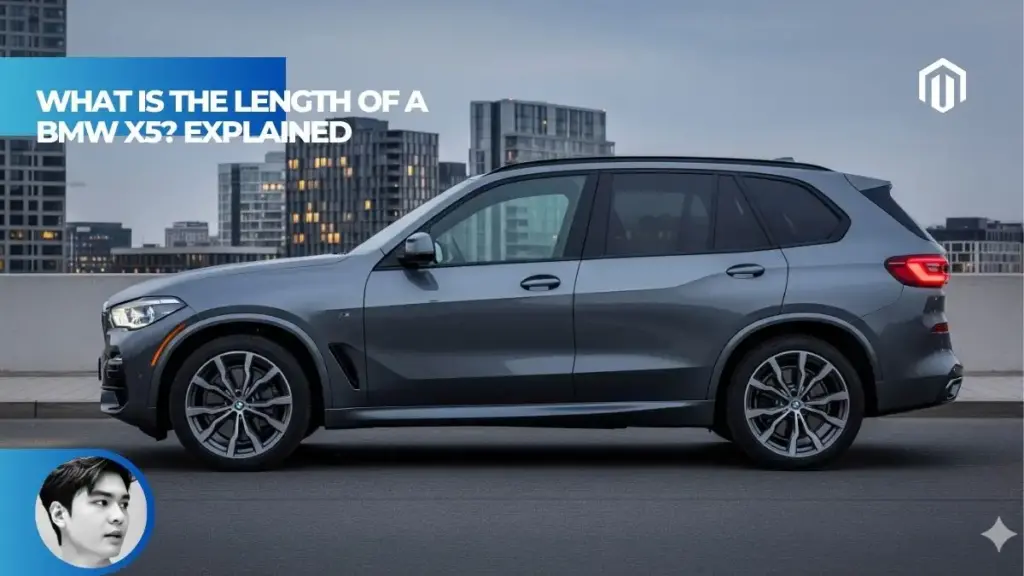You may also like:
The 2025 BMW X5 measures 194.3 inches (4,935 mm) in length for standard models, with the high-performance X5 M Competition extending slightly to 194.8 inches (4,948 mm)[1]. The wheelbase spans 117.1 inches (2,975 mm) across all variants[1]. This positions the X5 as a mid-size luxury SUV—slightly shorter than the Audi Q7 (199.6 inches) but nearly identical to the Mercedes-Benz GLE (194.3 inches)[2].
Complete BMW X5 Dimensions
| Dimension | Standard Models | X5 M Competition |
|---|---|---|
| Length | 194.3 in (4,935 mm) | 194.8 in (4,948 mm) |
| Width (without mirrors) | 78.9 in (2,004 mm) | 82.9 in (2,105 mm) |
| Width (with mirrors) | 87.3 in (2,217 mm) | ~89 in (~2,260 mm) |
| Height | 69.5 in (1,765 mm) | 69.4 in (1,762 mm) |
| Wheelbase | 117.1 in (2,975 mm) | 117.1 in (2,975 mm) |
| Ground clearance | 8.3 in (212 mm) | 8.3 in (212 mm) |
| Turning circle | 41.3 ft (12.6 m) | 41.3 ft (12.6 m) |
Source: Edmunds, CarsGuide[1][3]
The X5 M Competition is wider due to its aggressive fender flares accommodating larger 21-inch wheels with wider tires. Otherwise, the fundamental platform dimensions remain consistent across the lineup.
Interior and Cargo Space
The X5’s generous exterior dimensions translate into competitive interior space for the mid-size luxury SUV segment[4].
Passenger Dimensions
| Measurement | Front | Rear |
|---|---|---|
| Headroom | 40.8 in | 39.9 in |
| Legroom | 39.8 in | 37.4 in |
| Shoulder room | 60.0 in | 58.1 in |
Cargo Capacity
| Configuration | Volume |
|---|---|
| Behind 2nd row | 33.9 cu ft |
| Seats folded | 72.3 cu ft |
| Cargo floor length (to 2nd row) | ~42 in |
| Cargo floor length (to 1st row) | 69.0 in |
The xDrive50e plug-in hybrid variant offers slightly less cargo space (33.0 cu ft) due to battery placement[5].
BMW X5 vs Competitors
When shopping for a mid-size luxury SUV, size comparisons matter for both practicality and parking considerations[2].
| Dimension | BMW X5 | Mercedes GLE | Audi Q7 |
|---|---|---|---|
| Length | 194.3 in | 194.3 in | 199.6 in |
| Width | 78.9 in | 84.9 in | 77.6 in |
| Height | 69.5 in | 70.7 in | 67.1 in |
| Wheelbase | 117.1 in | 117.9 in | 118.1 in |
| Cargo (seats up) | 33.9 cu ft | 33.6 cu ft | 14.2 cu ft* |
| Seating | 5 | 5 | 7 |
*Audi Q7’s cargo figure reflects space behind its standard third row
The Audi Q7 is notably longer due to standard third-row seating[2]. The BMW X5 and Mercedes-Benz GLE are virtually identical in length, though the GLE is significantly wider when measured with mirrors (89.8 inches).
If you’re comparing BMW maintenance costs against these competitors, the X5’s mid-pack positioning continues across ownership expenses.
Garage and Parking Fit Guide
Understanding real-world fit is crucial before purchasing a vehicle of this size.
Standard Garage Fit
| Garage Type | Typical Size | X5 Fit Assessment |
|---|---|---|
| Single-car | 12′ × 20′ | Tight—minimal clearance |
| Standard two-car | 20′ × 20′ | Fits comfortably |
| Oversized two-car | 24′ × 24′ | Excellent fit |
With the X5’s length of 194.3 inches (16.2 feet), a standard 20-foot deep garage provides approximately 3.8 feet of clearance when parked[1]. This accommodates walking around the vehicle and opening the tailgate partially.
The 87.3-inch width with mirrors requires careful attention in narrower garages. Standard parking spaces (8.5–9 feet wide) accommodate the X5 comfortably, though tight spaces may require folding mirrors.
Turning Circle Considerations
The X5’s 41.3-foot turning circle is manageable for most urban situations but tighter than some competitors[3]. U-turns on standard two-lane residential streets require approximately 1.5 maneuvers.
2025 BMW X5 Powertrain Specifications
| Model | Engine | Power | Torque | 0-60 mph |
|---|---|---|---|---|
| xDrive40i | 3.0L turbo I6 | 375 hp | 398 lb-ft | 5.0 sec |
| xDrive50e | 3.0L I6 + electric | 483 hp | 516 lb-ft | 4.6 sec |
| M60i xDrive | 4.4L twin-turbo V8 | 523 hp | 553 lb-ft | 4.0 sec |
| X5 M Competition | 4.4L twin-turbo V8 | 617 hp | 553 lb-ft | 3.7 sec |
All models pair with an 8-speed automatic transmission and BMW’s xDrive all-wheel-drive system[1].
For detailed information on BMW longevity and reliability, engine selection impacts long-term ownership experience.
Fuel Economy
| Model | City | Highway | Combined |
|---|---|---|---|
| xDrive40i | 21 mpg | 26 mpg | 23 mpg |
| M60i xDrive | 17 mpg | 23 mpg | 19 mpg |
| xDrive50e (hybrid) | 50 MPGe | — | — |
| X5 M Competition | 13 mpg | 18 mpg | 15 mpg |
The xDrive50e plug-in hybrid offers approximately 30 miles of all-electric range before the gasoline engine engages[6].
Key Takeaways
- The 2025 BMW X5 measures 194.3 inches (16.2 feet) in length, with the X5 M Competition slightly longer at 194.8 inches
- Width is 78.9 inches without mirrors, expanding to 87.3 inches with mirrors extended
- The X5 shares nearly identical dimensions with the Mercedes-Benz GLE, while the Audi Q7 is approximately 5 inches longer
- Cargo capacity ranges from 33.9 cubic feet (seats up) to 72.3 cubic feet (seats folded)
- A standard 20-foot garage depth accommodates the X5 with reasonable clearance for walking around the vehicle
Frequently Asked Questions
Will a BMW X5 fit in a standard garage?
Yes, the BMW X5 fits in most standard garages with a 20-foot depth[1]. At 194.3 inches (16.2 feet) long, the X5 leaves approximately 3.8 feet of clearance. However, narrow single-car garages may present challenges with the 87.3-inch width including mirrors. Consider measuring your specific space before purchase.
Is the BMW X5 bigger than the Mercedes GLE?
The BMW X5 and Mercedes-Benz GLE are nearly identical in length at 194.3 inches[2]. However, the GLE is wider (84.9 inches vs 78.9 inches without mirrors) and slightly taller (70.7 inches vs 69.5 inches). Interior cargo space is virtually identical at 33.6–33.9 cubic feet behind the second row.
How does the BMW X5 compare to the X7 in size?
The BMW X7 is significantly larger, measuring approximately 203 inches in length—nearly 9 inches longer than the X5[3]. The X7 also offers standard third-row seating for up to seven passengers, while the X5 seats five. If you need maximum passenger capacity, the X7 is the appropriate choice.
What is the cargo space in a BMW X5?
The BMW X5 provides 33.9 cubic feet of cargo space behind the second row and expands to 72.3 cubic feet with rear seats folded[4]. The cargo floor length from the tailgate to the second row measures approximately 42 inches, expanding to 69 inches with seats folded. The plug-in hybrid xDrive50e offers slightly less at 33.0 cubic feet.
References
- Edmunds. (2025). 2025 BMW X5 Specs & Features. https://www.edmunds.com/bmw/x5/2025/features-specs/
- CarHP India. (2025). Mercedes-Benz GLE vs Audi Q7 vs BMW X5 Comparison. https://carhp.in/compare-cars/mercedes-benz-gle-vs-audi-q7-vs-bmw-x5
- CarsGuide. (2025). BMW X5 Dimensions 2025 – Length, Width, Height, Turning Circle. https://www.carsguide.com.au/bmw/x-models/x5/car-dimensions/2025
- BMW of Dallas. (2024). 2024 BMW X5 Dimensions & Cargo Space. https://www.bmwofdallas.com/research/bmw-x5-dimensions.htm
- Grayson BMW. (2025). 2026 BMW X5 Cargo Space & Interior Dimensions. https://www.graysonbmw.com/research/bmw-x5-cargo-space-interior-dimensions.htm
- BMW USA. (2025). BMW X5 Midsize Luxury Crossover SUV. https://www.bmwusa.com/vehicles/x-series/x5/bmw-x5.html

I am a senior automotive analyst at Autvex. Expert vehicle evaluations, in-depth reviews, and objective analysis helping readers make informed automotive decisions with years of industry experience.









